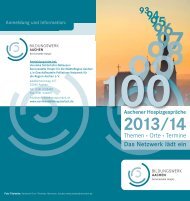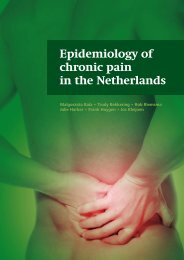First EFIC® Symposium Societal Impact of Pain - SIP
First EFIC® Symposium Societal Impact of Pain - SIP
First EFIC® Symposium Societal Impact of Pain - SIP
Create successful ePaper yourself
Turn your PDF publications into a flip-book with our unique Google optimized e-Paper software.
Eli Alon<br />
Pr<strong>of</strong>essor Eli Alon, M.D.<br />
Pr<strong>of</strong>essor <strong>of</strong> Anesthesiology University, Zurich<br />
• Pr<strong>of</strong>essor <strong>of</strong> Anesthesiology University <strong>of</strong><br />
Zurich<br />
• Director <strong>Pain</strong> Control Unit Beder Str 80,<br />
8002 Zurich, Switzerland<br />
• Consultant for <strong>Pain</strong> Medicine Zurich University<br />
Hospital<br />
• Past-President <strong>of</strong> the Swiss Association for<br />
the Study <strong>of</strong> <strong>Pain</strong> SGSS<br />
• Executive Board Member <strong>of</strong> The European<br />
Federation <strong>of</strong> IASP Chapters EFIC<br />
• Former Chairman Department <strong>of</strong> Anesthesiology<br />
Regional Hospital <strong>of</strong> Lugano,<br />
Switzerland<br />
• Lecturer at the University <strong>of</strong> Zurich and at<br />
the University Hospital<br />
• Organizer and invited speaker in National,<br />
European and International Congresses<br />
• Author <strong>of</strong> books, proceedings, original and<br />
review articles, book chapters, and abstracts.<br />
Chronic pain: a disease in its own right<br />
<strong>Pain</strong> is a major healthcare problem in Europe.<br />
Although acute pain may be considered a<br />
symptom <strong>of</strong> diease or injury, chronic and<br />
persistent pain is a specific healthcare<br />
problem, a disease on its own right.<br />
Acute pain, such as that following trauma or<br />
surgery, constitutes a signal to a concious<br />
brain about the presence <strong>of</strong> noxious stimuli<br />
and/or ongoing tissue damage. This acute pain<br />
signal is useful and adaptive, warning the<br />
individual <strong>of</strong> danger and the need to escape or<br />
seek help. Acute pain is a direct outcome <strong>of</strong> the<br />
noxious event, and is reasonable classified as<br />
a symptom <strong>of</strong> underlying tissue damage or<br />
disease. However, in many patients pain<br />
persists long after its usefulness as an alarm<br />
signal has passed, and indeed, <strong>of</strong>ten long after<br />
the tissue damage has healed. Chronic pain in<br />
these patients is probably not directly related<br />
to their initial injury or disease condition, but<br />
rather to secondary changes including ones<br />
that occur in the pain detection system itself.<br />
In addition to being due to different<br />
physiological mechanismus than acute pain,<br />
chronic pain <strong>of</strong>ten sets the stage for the<br />
emergence <strong>of</strong> a complex set <strong>of</strong> physical and<br />
psychosocial changes that are an integral part<br />
<strong>of</strong> the chronic pain problem and that add<br />
greatly to the burden <strong>of</strong> the pain patient.<br />
23






